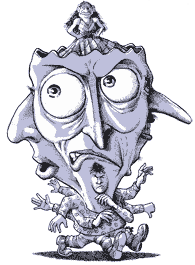Renee blogs:
Yolanda Charley, recently won the title of Miss. Navajo Nation. I am normally against beauty contests, as I see them as nothing more than the performance of femininity for the male gaze. The Miss Navajo Nation is like no other pageant I have ever come across.
…
What I love about this contest is that it is more than women parading around with fake smiles, with their bathing suits taped to their skin, to avoid being swallowed by their asses. Miss Navajo is about celebration, and the perpetuation of culture.




Hm. After reading the link, I’d contest calling this a “beauty contest”. It seems that the idea was to find a young woman that had command of various aspects of her native culture and that was a good communicator and could best represent her culture and her people to others from among the contestants. Which is a damn good idea. I don’t know why you’d want to compare this to a beauty pageant in the first place.
It does sound like a very cool competition.
But could a conventionally ugly woman be acclaimed the winner, if she turned out to be the best at all of the sheep-butchering and other such tasks? If not, then I’d say it’s still fair to call it a “beauty contest.” The young woman is supposed to be a representative of the people for assorted PR purposes, right, and I rather get the impression that a large part of that role is being perceived of as…well, as decorative. As a pretty young thing. Gracious, intelligent, articulate, talented, yes, yes, all that, but also at base level? Harmless. Not overly imbued with gravitas, and not too threatening, and always easy on the
male gazeeyes. As a young woman is supposed to be.I’d also say that since the Miss Navajo contest organizers chose to incorporate all the signs and signifiers of ‘beauty pageant’ into their competition — the sash, the crown, the “Miss X” title, etc. — it’s hardly unfair if people then turn around and call it a beauty pageant. It has, after all, been deliberately presented as such.
I say none of this, though, to in any way disparage the winner, on whom the article focused. She sounds like an exemplary person, with very impressive skills.
Oh, it already happened this year?
I usually read about the contestants in the Navajo Times. Seems more like Rodeo Queen/Harvest Priness/State Fair etc. contest than a beauty pageant. And yeah, ugly folks tend not to make the cut in those, mostly… Maybe I can find more background on the rules.
I thought that too, Elkins, but check out the link. There were four young women in the competition, and (to my eyes anyway) the winner is the least conventionally attractive of the four. I suspect a majority of people would broadly agree with my ranking.
Not that I would normally opine on such things (here, anyway) but it seems relevant. It looks like the sheep-butchering and the Navajo fluency etc. are the deciding factors, not attractiveness.
I am Full Blooded Navajo and I know that the Miss Navajo competition is a tough one. I think that for those few brave girls that do apply it is noted on the application that Beauty is a requirement.
I grew up on the REZ only about 2 or 3 kids in my grade were Fat. It wasn’t common then. One of our traditions is that every morning get up before the sun rises and you run to greet the sun. I wonder what happened to that tradition on her list?
I think that those who were judging the Miss Navajo contest should of considered that this girl would be representing Us. She will also be a great influence on the young women of the Navajo Nation. I don’t think that an obese beauty queen is what Our Nation needs in a time when Heart Disease and Diabetes is rapidly growing.
Larissa, ultra-thin people — and the winners of conventional beauty contests are usually much, much thinner than average — are, if anything, more in danger of an early death associated with their weight, than most fat people are.
If the logic is that, in order to provide healthy role models, only people whose weight is associated with longer life spans should be permitted to win, then all beauty contest winners should in fact be slightly “overweight.”
In my opinion, however, that entire line of logic is wrong. Role models can come in all weights.
@Amp – I remember that article and I’m always confused by it. I mean, at what age? Even people who are naturally underweight in their youth tend to swing to the far side of the bar as they age. My wholly unsubstantiated assumption would be that the healthiest people are the ones who are athletic and slim when they’re under 30, and somewhat less athletic (but still active) and slightly overweight as they approach retirement age.
I never indicated ULTRA-THIN people were healthy. I just think that the judges knew she would become the front person to represent Navajo Traditions and the youth should’ve considered the fact that this girl is Obese. I just hope that she tries to make a change for a healthier lifestyle.
She needs to uphold our tradition of running in the morning. If the contest is all about traditions why was that one ignored?
Larissa, I’m glad that isn’t what you meant. But in most beauty contests, the winners are much, much thinner than average for the US, and no one seems to worry about their health. (I met a recent Miss America a couple of years ago, and was surprised at how much thinner she looked in person than on TV).
As for the lovely Ms. Charley, you shouldn’t assume that just because she’s fat, she doesn’t exercise or live a healthy lifestyle. (Since the competition Ms. Charley won includes dancing, sheep butchering and grinding corn, it seems unlikely that she leads a physically inactive life.)
It’s really unfortunate that you look at someone’s waistline and assume they know how that person eats and exercises. The world isn’t as simplistic as you imagine it is; some thing people eat lousy diets and are couch potatoes (and there’s nothing wrong with that!), and some fat people eat well and are active.
SiF, the studies I’ve seen are of adults. It’s true that the extra mortality risk of being fat — never high in the first place — drops with age. However, the extra mortality risk of being thin — while never all that high, even though it’s higher than that for being fat — exists at all ages, iirc.